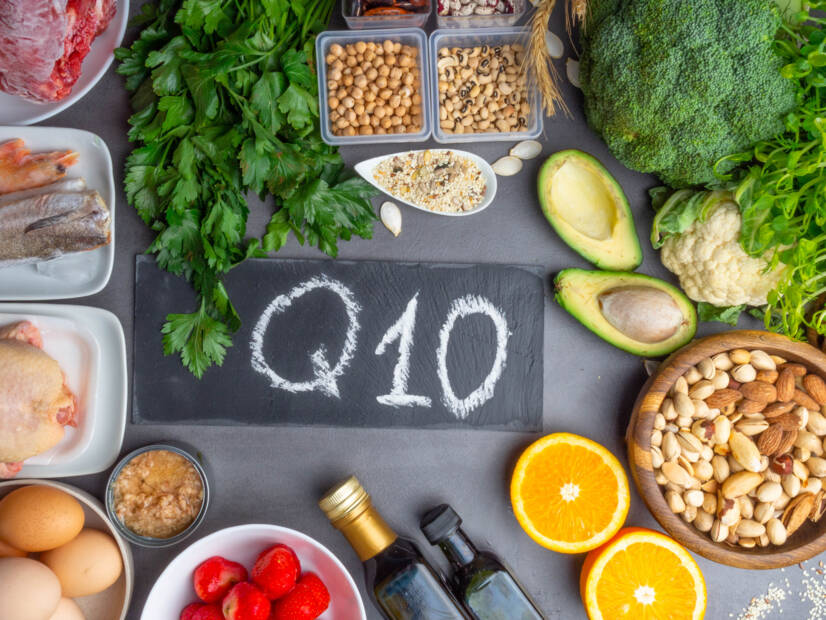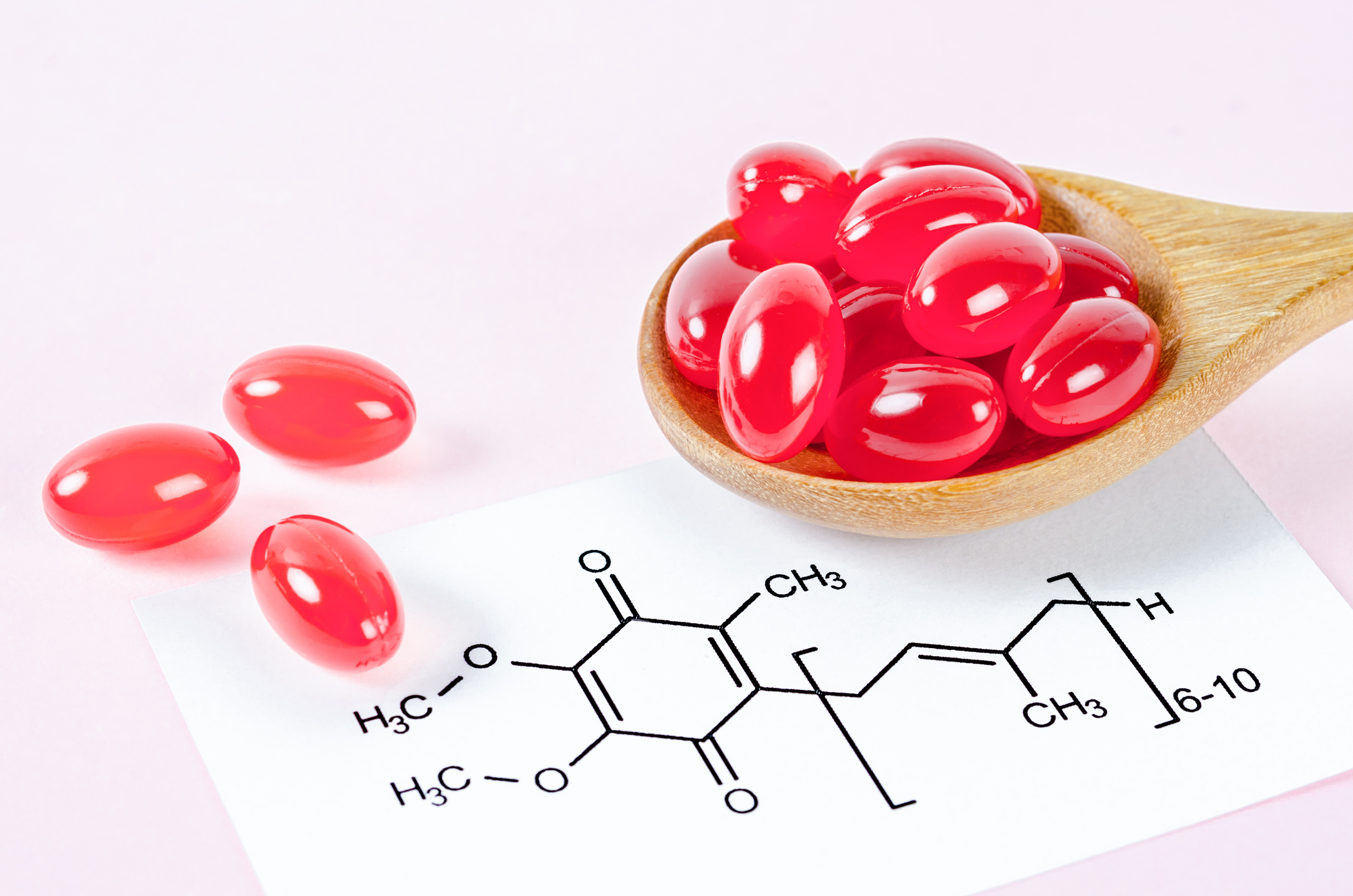- ncbi.nlm.nih.gov - Coenzyme Q10; Albert E. Raizner
- ncbi.nlm.nih.gov - Disorders of Human Coenzyme Q10 Metabolism: An Overview; Iain Hargreaves, Robert A. Heaton, and David Mantle
- ncbi.nlm.nih.gov - Coenzyme Q10: Novel Formulations and Medical Trends; Carmen J. Pastor-Maldonado, Juan M. Suárez-Rivero, Suleva Povea-Cabello, Mónica Álvarez-Córdoba, Irene Villalón-García, Manuel Munuera-Cabeza, Alejandra Suárez-Carrillo, Marta Talaverón-Rey, José A. Sánchez-Alcázar
- ncbi.nlm.nih.gov - Coenzyme Q10; Brittany Sood; Michael Keenaghan
Coenzyme Q10: What is it and what are its effects, importance + dosage

Coenzyme Q10 plays an important role in cellular metabolism, which is why its deficiency is associated with a number of disorders and diseases in the human body. The tissues of the brain, muscles and kidneys are particularly susceptible to the metabolic consequences of its deficiency.
Article content
Coenzyme Q10 occurs naturally everywhere in nature. Yet it is one of the most widely used dietary and nutritional supplements on the market.
Coenzyme Q10 was discovered in the 1950s by Festenstein in 1955 and identified by American scientist Frederick Crane and his colleagues in 1957.
The name coenzyme Q10 is not accidental. It was derived from its chemical structure. It is made up of a benzoquinone ring (from benoquinone) with a side chain. In humans, it is made up of 10 isoprene units.

Coenzyme Q10 exists in three forms (oxidized, reduced and neutral). Its structure may resemble that of vitamins - e.g. vitamin K. However, it is not classified as a vitamin.
Vitamins are essential compounds. Our body cannot make them and we have to take them in food. Coenzyme Q10, on the other hand, is synthesized in our body.
What are its properties and effects?
Coenzyme Q10 plays an indispensable role in the formation of ATP, and thus in the bioenergetics of the cell. Thanks to this property, it is also used clinically, for example in heart problems.
Another very important property is its antioxidant activity. This means that it acts as a free radical scavenger in our body.
It can also recycle and regenerate other antioxidant substances in our body. For example, vitamin C and also vitamin E.
In addition to the above properties, coenzyme Q10 also contributes to:
- cell signaling
- gene expression
- membrane stabilization
It also plays a role in:
- as a mediator of inflammation
- in cholesterol metabolism
- in the maintenance of lysosomal pH
- in amino acid metabolism
- and other processes
Coenzyme Q10 exists in an oxidized form (ubiquinone) and also in a reduced form (ubiquinol). The constant transformation between these two or three forms ensures the normal functioning of the coenzyme.
Coenzyme Q10 is absorbed in our digestive tract - specifically in the small intestine. Its molecule is lipophilic. Therefore, if we want to increase its absorption, it is ideal to take it with a diet rich in fat.
After absorption from the small intestine, coenzyme Q10 travels to the liver where it is incorporated into lipoprotein particles (VLDL/LDL). With these it then enters the bloodstream.
The maximum plasma concentration occurs six to eight hours after ingestion of the coenzyme product. However, its elimination half-life is longer than 30 hours.
Coenzyme Q10 is produced by a fermentation process with the help of yeast. The coenzyme thus obtained is in the form of crystals. However, these cannot be absorbed in our digestive tract. Therefore, they must be subsequently dispersed (evenly dispersed) into their individual molecules.
However, this dispersion must remain stable throughout the shelf life of the product. Only in this way can absorption and subsequent effects be ensured.
There are various products on the market containing coenzyme Q10:
- tablets
- powder-filled capsules
- oil suspensions in soft gel capsules
Studies have shown that the reduced form of coenzyme Q10 ubiquinol has better bioavailability. Although in general the efficacy of orally applied coenzyme Q10 is low.
However, traditional preparations of coenzyme Q10 are not very suitable. The bioavailability of coenzyme is still relatively low.
Absorption is particularly compromised by its:
- poor water solubility
- instability in light
- thermolabile
Therefore, research and development has recently been carried out on forms that would increase this absorption. In particular:
- solid dispersion systems
- oil solution
- suspension systems
- nanoparticles
- inclusion compounds
- microcapsules
- and nanoliposomes
The latter show the most promising results. Research shows that:
- they improve stability
- prolong circulation time in the blood
- increase bioavailability
However, the biggest disadvantage of liposomal coenzyme Q10 is its high instability. This was eliminated by lyophilisation - freeze drying. The lyophilised coenzyme showed stable properties even with long-term storage.
Coenzyme Q10 is available in different doses. Preparations containing it are 30, 60, 100, 200, 300, 400, 600 mg. Although there is no minimum or maximum dose, the average daily dose is 200 mg (some sources state 250 mg) twice a day.
The acceptable daily dose has been established at 12 mg/kg. Ideally, the preparations should be taken with food.
This amount is calculated on the basis of the total body supply of the coenzyme. This amounts to 2 000 mg and an average tissue turnover time of 4 days.
However, higher daily doses have been described in some studies. Daily doses ranging from 100 to 400 mg have been used in cardiac diseases. Doses up to 600 to 3 000 mg have been used in neurodegenerative diseases.
However, such extreme doses are not recommended in the case of self-treatment with coenzyme. The daily dosage should definitely be followed.
Only a very small amount of coenzyme - something around 5 mg - is ingested daily through the diet. Most of the daily requirement of coenzyme Q10 is produced in our body.
Coenzyme Q10 is found in all the tissues of our body.
However, the organs that contain the most of it are:
- high energy requirements
- high metabolic activity
It is therefore mainly found and synthesized in:
- the heart
- kidneys
- liver
- muscles
In these organs it is found in reduced form.
Many studies have recently demonstrated the potential action of coenzyme Q10:
- against the harmful effects of ultraviolet radiation.
- in multiple system atrophy - MSA
- in familial hypercholesterolaemia
We all know that excessive sun exposure is extremely harmful to our bodies. Sunlight (specifically UVB) causes reactive oxygen species to form in our cells. These are among the most damaging free radicals.
As a result of their overproduction, pathological changes appear on the skin, such as:
- Erythema
- Eczema
- sunburn
- suppression of immunity
- Cancer
The protection against these side effects is, of course, the use of sunscreens. However, these cannot capture these reactive forms. This is where coenzyme Q10 and its antioxidant effects come in.
Ideally, its action is supported by vitamin E, which also acts as an antioxidant.
Coenzyme Q10 can be produced by the body itself. However, its production decreases with age. It is optimal around the age of 25.
At the age of 65, its production is up to half that at the age of 25. Its production also usually decreases in the case of various diseases.
In these cases, it is therefore advisable to supplement coenzyme Q10 with dietary supplements or medication.
Since coenzyme Q10 is natural to our bodies, it should generally be well tolerated.
Even so, mild side effects may occur, such as:
- reduced appetite
- diarrhea
- dizziness
- dyspepsia
- feeling sick and vomiting
Coenzyme Q10 deficiency and its manifestations
Coenzyme Q10 deficiency is generally divided into:
- Primary - resulting from mutations in genes involved in the synthesis of coenzyme Q10
- Secondary - results from non-genetic factors, e.g.:
- cardiovascular disease
- chronic kidney disease
- type II diabetes mellitus
- metabolic syndrome
- phenylketonuria, but also other
Primary deficiency
Primary coenzyme deficiencies can affect any part of the human body. However, they are most sensitive due to their energy requirements:
- the brain - the manifestation is usually ataxia (so-called movement coordination disorder), but also other neurological manifestations
- muscles - their deficiency, especially in the heart muscle, leads to its weakening, which is manifested by hypertrophic cardiomyopathy
- kidneys - its deficiency leads to nephrotic syndrome and impaired kidney function
The severity of the symptoms can vary. Very severe conditions can manifest in childhood. There are five clinical phenotypes:
- severe multisystem disease in childhood
- nephropathy
- cerebellar ataxia and atrophy
- encephalomyopathy
- isolated myopathy
Less severe forms may not manifest until later in life - around age 60.
Research is currently underway to develop a method of determining coenzyme Q10 from a drop of blood from newborns at screening. This would ensure early treatment without organ damage.
Secondary deficiency
This condition occurs in diseases such as:
- cardiovascular disease
- Type II diabetes
- chronic kidney disease
- chronic liver disease
Coenzyme deficiency in these diseases can compromise the cell's antioxidant status. Furthermore, it can result in impaired function of cellular structures and reduced energy supply to the cell. This can result, for example, in heart failure.
However, a large number of disorders that are associated with either primary or secondary coenzyme deficiency are successfully treated by supplementation.
Coenzyme Q10 can also be depleted by certain medications. These include:
- cholesterol medications
- antidepressants - amitriptyline
In the case of amitriptyline, it is not clear how it contributes to coenzyme Q10 deficiency. It is thought that one reason may be the increase in oxidative stress by this treatment.
As for cholesterol medication, there is a known reason.
In the case of elevated cholesterol levels, drugs - called statins - are very often prescribed. These are a group of drugs that resemble each other in their chemical structure. Their effect is ensured by the reduced production of cholesterol.
However, they also reduce the production of ubiquinone - a reduced form of coenzyme Q10, or coenzyme itself, which is essential for cells.
Studies have shown reduced concentrations of coenzyme Q10 when taking statins, in:
- blood
- the heart
- and liver
Statins also lower so-called LDL cholesterol. These low-density lipoproteins (LDL) are the main carriers of coenzyme Q10.
Coenzyme Q10 deficiency can lead to:
- impaired antioxidant defences
- impairment of normal tissue function - this is particularly associated with older age
Coenzyme Q10 and its use in diseases
Coenzyme Q10 increases ATP production. At the same time, it may also reduce oxidative stress - a hallmark of mortality in heart failure.
Patients who suffer from heart failure have a deficiency of coenzyme Q10 in the blood, but also in the heart tissue. This deficiency of coenzyme Q10 has also been shown to be directly related to the degree of damage to the left ventricle of the heart.
Externally administered coenzyme increases its levels in the blood and tissues. It may also be incorporated into the mitochondria.
This action may hypothetically have a beneficial therapeutic effect. It is hypothetical because most clinical trials have been limited by the small number and scarcity of current therapeutic agents.
However, researchers in one study concluded that long-term treatment with coenzyme Q10 in patients suffering from chronic heart failure is:
- safe
- improves symptoms
- reduces serious adverse clinical events

Although coenzyme Q10 is one of the very popular dietary and nutritional supplements on the market, large-scale, multicenter, randomized, controlled studies on heart failure are needed.
It is also worth noting that coenzyme Q10 is not usually classified as a drug - only as a dietary supplement.
As for chronic kidney disease, patients with this diagnosis had reduced plasma concentrations of coenzyme Q10. Whether they were hemodialysis patients or not.
One randomized trial confirmed that administration of coenzyme Q10 can lead to improved kidney function. In these patients, it also reduced the need for dialysis. In this study, patients received 100 mg 3 times a day for three months.
In the case of liver disease, studies have shown reduced blood concentrations of coenzyme in patients with non-alcoholic fatty liver disease. This reduction correlated with inflammation and liver cirrhosis. Patients who received 100 mg once daily for four months had:
- reduced levels of inflammatory features
- reduced levels of oxidative stress traits
However, there are relatively few studies. Therefore, it is not possible to confirm or refute with certainty either the benefits or the side effects. Therefore, always consult your health and the use of coenzyme Q10 with your treating physician.
Coenzyme Q10 has a similar chemical structure to vitamin K.
It has even been found to interact with the coenzyme warfarin. This can lead to failure of anticoagulant treatment. Therefore, patients taking this blood thinning medication should avoid products with coenzyme Q10.
Coenzyme Q10 is found on the market in various forms and strengths. However, it is very important to note that any coenzyme Q10 used in clinical trials is manufactured to pharmaceutical standards.
Equally integral is the proof of its usefulness in the human body.
Coenzyme Q10 is one of the most popular dietary supplements. Its molecule is the subject of constant study. Many doctors, health professionals and pharmacists therefore see patients with various diagnoses who are taking or considering taking coenzyme Q10 on a daily basis.
Properly informing and educating patients about their condition and the use of coenzyme Q10 reduces side effects. At the same time - and this is a not insignificant benefit - it increases the chances of taking it correctly.
Interesting resources
Related










